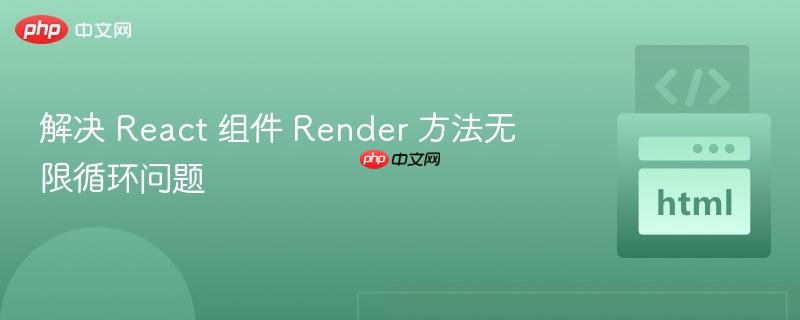
本文旨在帮助开发者诊断并解决 React 组件 render() 方法陷入无限循环的问题。通过分析问题代码,我们将深入探讨导致循环的原因,并提供切实可行的解决方案,确保组件正常渲染,避免性能问题。主要内容包括:分析fetchFavCities() 函数在 render() 中调用的潜在问题,以及如何将其移至更合适的生命周期方法中,以避免无限循环。
React 组件的 render() 方法负责描述组件的 UI,并根据组件的 props 和 state 返回 JSX。然而,如果在 render() 方法内部不小心引入了会导致状态更新的操作,就可能触发无限循环,导致性能问题甚至应用崩溃。
最常见的原因是在 render() 方法内部调用了会改变组件状态的方法。由于 render() 方法在状态改变时会被重新调用,如果在 render() 内部改变状态,就会再次触发 render(),从而形成无限循环。
以下面的代码为例,问题在于在主组件的 render() 方法中调用了 fetchFavCities(),该方法通过 axios 发起网络请求,并在请求成功后使用 this.setState 更新组件的状态。
render() {
this.fetchFavCities();
return (
// ... JSX ...
)
}由于 fetchFavCities() 会更新 this.state.favCts,每次 render() 调用 fetchFavCities() 都会导致状态改变,从而触发组件重新渲染,形成无限循环。
解决此问题的关键是将 fetchFavCities() 移至 componentDidMount 生命周期方法中。componentDidMount 在组件挂载后只会被调用一次,非常适合执行副作用操作,如网络请求。
修改后的代码如下:
componentDidMount() {
this.fetchFavCities();
}
render() {
return (
// ... JSX ...
)
}这样,fetchFavCities() 只会在组件挂载时调用一次,避免了在每次 render() 时都发起网络请求并更新状态,从而解决了无限循环的问题。
以下是包含修改后的 componentDidMount 的完整组件代码:
class MyComponent extends React.Component {
constructor(props) {
super(props);
this.state = {
favCts: [],
postcodeInput: '',
displayResult: false
};
this.handleSubmit = this.handleSubmit.bind(this);
this.handleInputChange = this.handleInputChange.bind(this);
this.fetchFavWeather = this.fetchFavWeather.bind(this);
}
async getCoord() {
let city = {
cityname: this.state.postcodeInput
}
axios.post('http://localhost:4001/search-location', city)
.then((response) => {
console.log(response);
this.setState({
displayResult: true
});
}, (error) => {
console.log(error);
});
}
handleSubmit(e) {
e.preventDefault();
this.getCoord();
}
handleInputChange(e) {
this.setState({
postcodeInput: e.target.value,
displayResult: false
});
}
fetchFavWeather(city) {
this.setState({
displayResult: false,
postcodeInput: city
}, () => {
console.log("passing fav to forcast" + this.state.postcodeInput);
this.getCoord()
});
}
fetchFavCities() {
axios.get('http://localhost:4001/favouriteCites')
.then((res) => {
this.setState({
favCts: res.data
})
});
}
componentDidMount() {
this.fetchFavCities();
}
render() {
return (
<div>
<form onSubmit={this.handleSubmit}>
<div>
<div className="column">
{
this.state.favCts.map(
(item, index) => <button key={index} onClick={() => { this.fetchFavWeather(item) }}>{item}</button>
)}
</div>
<div className="control">
<input className="input" type="text" placeholder="input city here" onChange={this.handleInputChange} required />
</div>
<div className="field">
<div className="control">
<input type='submit' className="button is-light is-large" value='Check Weather' />
<input type='submit' className="button is-light is-large" value='Save as Favourite' onClick={this.saveAsFavourite} />
</div>
</div>
</div>
</form>
<div className="column">
{this.state.displayResult ? <WeatherResult /> : null}
</div>
</div>
)
}
}在 React 组件中,避免在 render() 方法中直接修改状态是至关重要的。通过将副作用操作移至合适的生命周期方法,可以有效地防止无限循环,提高应用的性能和稳定性。理解 React 的生命周期以及 render() 方法的职责是编写高质量 React 应用的基础。
以上就是解决 React 组件 Render 方法无限循环问题的详细内容,更多请关注php中文网其它相关文章!

每个人都需要一台速度更快、更稳定的 PC。随着时间的推移,垃圾文件、旧注册表数据和不必要的后台进程会占用资源并降低性能。幸运的是,许多工具可以让 Windows 保持平稳运行。

Copyright 2014-2025 https://www.php.cn/ All Rights Reserved | php.cn | 湘ICP备2023035733号